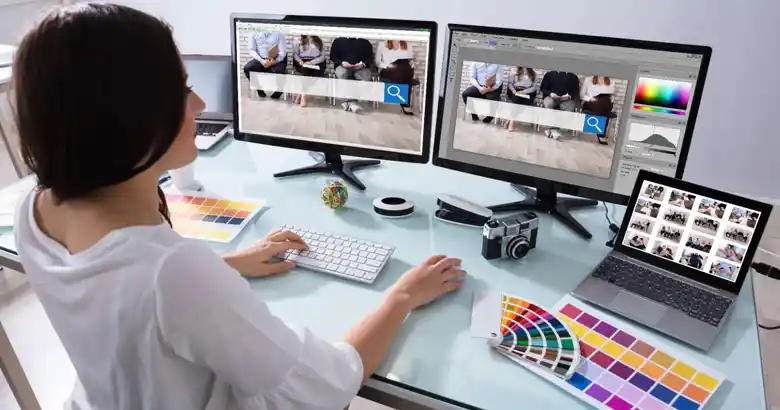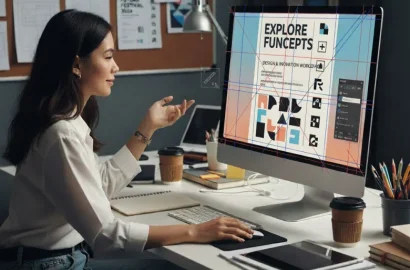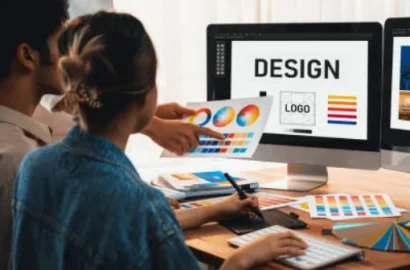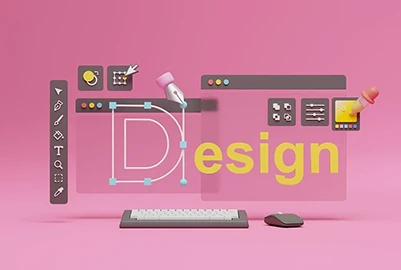This holistic guide covers the crucial soft, technical, and software skills necessary for graphic designers, with tips on how to master them.
Graphic design is a creative role—but it’s not all about hands-on design work. In addition to artistic flair, the best graphic designers must also possess excellent communication and collaboration skills, technical expertise, and proficiency in industry tools.
If you’re curious about what it takes to excel as a graphic designer, keep reading.
We’ve compiled the most important graphic design skills employers are looking for in 2026, together with advice on how to acquire them.
- 1) What is graphic design and what do graphic designers do?
- 2) 6 Essential hard skills for graphic designers
- 3) Additional graphic design hard skills (nice-to-haves)
- 4) 5 Must-have soft skills for graphic designers
- 5) Essential software, tools, and programs all graphic designers should learn
- 6) How to develop the top graphic design skills and start a career in the field
- 7) Next steps

What is graphic design and what do graphic designers do?
Graphic design is the art of creating visual content to communicate a certain message. It’s closely related to marketing, advertising, and branding, and uses different design elements and compositions to visually convey the ‘essence’ of a product.
Graphic design is everywhere, both in the physical world and the digital realm. It includes things like product labels and packaging, posters and billboards, book covers, website graphics, logos, flyers, and business cards.
Learn more: What Is Graphic Design? Everything You Need To Know.
It’s a broad and varied field, and the work of a graphic designer can differ greatly from one project to the next. But, ultimately, graphic designers are responsible for creating designs and individual design assets that connect with the target audience.
They use shapes, lines, colour, imagery, type/text, space, and texture to bring a concept to life—usually working from a project brief which sets out the deliverable to be designed, as well as who it’s for, the purpose it will serve, and any design/branding guidelines it should adhere to.
Graphic designers enjoy a creative, collaborative, and varied role. They can work in a range of industries and sectors, and there are many different career paths to choose from within the field.
Given the breadth and variety of the role, graphic designers require a broad and diverse skill set. Ready to discover the top skills you’ll need to become a graphic designer? Keep reading.
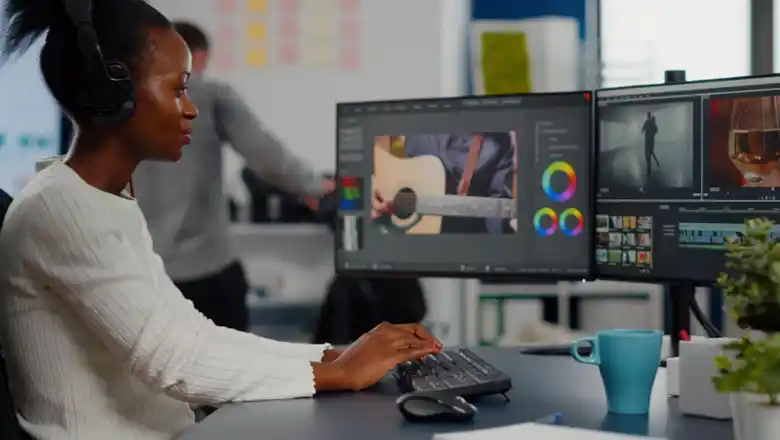
6 Essential hard skills for graphic designers
Graphic design hard skills are the technical, role-specific proficiencies that are essential for a role in graphic design. These include:
- Knowledge of graphic design principles
- An understanding of colour theory and colour psychology
- Proficiency in digital design
- Knowledge of branding
- The ability to design for print
- Proficiency in graphic design software
Let’s explore these in detail.
i. Knowledge of graphic design principles
Good graphic design doesn’t happen by accident. Throughout their work, graphic designers adhere to certain guiding principles—the “golden rules” of graphic design.
Some of the most important graphic design principles are balance, hierarchy, contrast, proportion, and repetition. These principles are crucial for the creation of aesthetically pleasing designs that accurately communicate the desired message—for example, by directing the user’s attention to certain elements on the page.
All graphic design roles require knowledge of these fundamental principles, so make sure you know what they are, why they’re important, and how to apply them to your work. A holistic graphic design course can also be of great benefit in this regard.
ii. An understanding of colour theory and colour psychology
Colour is one of the most powerful tools in a graphic designer’s armoury. If you want to excel as a graphic designer, you need to be well-versed in both colour theory and colour psychology.
Colour theory is the study of how colours are used in art and design. It includes knowledge of the colour wheel which depicts the relationship between primary, secondary, and tertiary colours; an understanding of concepts such as hue, saturation, and brightness; and developing an eye for effective colour pairings. You’ll find a great introduction to colour theory on the Sketch blog.
Colour psychology explores how different colours can impact people’s emotions, moods, and behaviour. For example, you’ve probably heard of red being associated with passion and excitement, blue being symbolic of peace and calm, and green representing nature and freshness.
To capture the essence of a particular brand and connect with the target audience, graphic designers must understand the role that colour plays and learn how to use it for maximum impact.
iii. Proficiency in digital design
We live in the digital age, so many graphic designers will find themselves working in the digital realm. As such, adding digital design skills to your repertoire is a must.
Some of the most important digital design skills include digital typography (using computer software to design type that will be viewed on-screen), creating logos and other web design elements (such as icons and buttons) from scratch, and designing assets, such as branded letterheads for email newsletters and banners for social media ads, for digital marketing and advertising campaigns.
Ultimately, the best-equipped graphic designers know how to translate and adapt their craft for the screen—honing their skills to span both physical and digital design.
iv. Knowledge of branding
Graphic designers rarely design in a vacuum. Usually, they’re designing for a specific brand and must therefore understand the relationship between visual design and branding.
Branding is the process of establishing and conveying a unique and memorable identity, be it for a product, a service, or a person. It’s the image and impression a brand projects to the world, declaring “This is who I am and what I stand for.”
There are many products and services which deliver the same thing, so companies must create a strong brand identity in order to differentiate themselves and resonate with their target audience. Graphic designers are often involved in this process—be it to help develop the brand identity itself, or design materials that accurately capture and reinforce the brand image.
As a graphic designer, it’s essential to understand how design helps to shape and communicate brand identity and to master the art of designing assets in accordance with brand guidelines.
v. The ability to design for print
The origins of graphic design can be traced back to the printing industry, and graphic design for print is still going strong. After all, we still need designers for things like product packaging, posters, magazines, and book covers.
To design for print, graphic designers must be skilled in layout design, typography, and colour, as well as prepress (the process of preparing your designs for printing), printing, bindery, and finishing.
Designing for print also requires proficiency in specific software (such as QuarkXpress or Adobe InDesign)—which leads us to the final hard skill on our list.
vi. Proficiency in graphic design software
Like most professionals nowadays, graphic designers use a range of specialist programs and tools. The exact tools you use will depend on the nature of your role and whether you specialise in a specific domain—for example, printing and publication or animation and motion graphics.
Still, most (if not all) graphic designers should be proficient in illustration and drawing software, as well as photo and video editing tools.
We list some of the most popular graphic design tools worth learning after our section on soft skills.
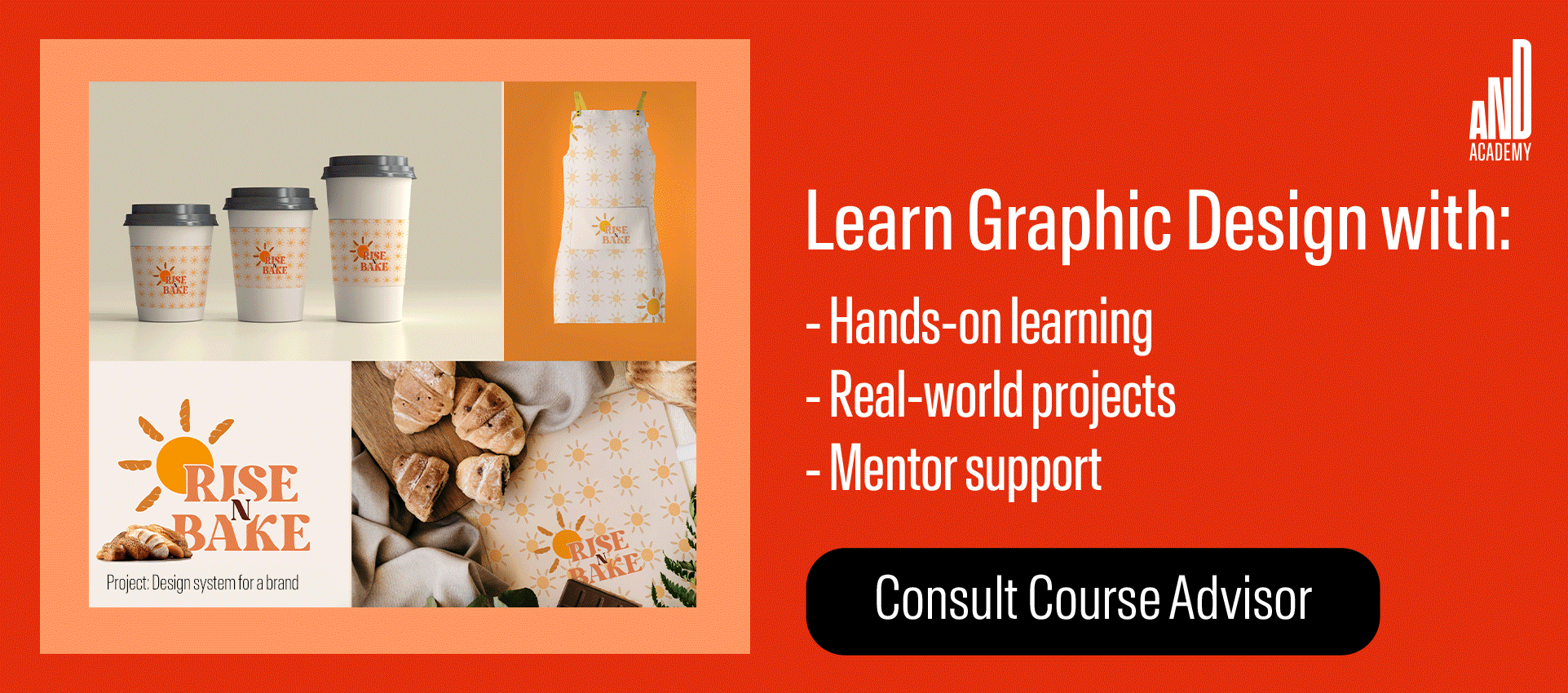
Additional graphic design hard skills (nice-to-haves)
What other hard skills might you add to your skill set?
Here are some nice-to-have skills that aren’t strictly necessary for becoming a graphic designer, but might be fun to learn and may also broaden your job prospects.
Photography. This is a common hobby among graphic designers, and it’s a useful skill to have. If you can take your own high-quality and expertly-shot photos, you’ll have access to unique images you can use in your work and enjoy full creative freedom—a big step up from stock photography.
Drawing, sketching, and illustration. Many aspiring graphic designers wonder if they need to be talented at drawing in order to work in the field, and the short answer is no. Most of your work will be done using digital tools, so drawing free-hand is not a prerequisite. That said, sketching and drawing can be a great way to develop your creativity and get into the habit of visualising your thoughts and ideas so you can share them with others.
Animation, special effects, and motion graphics. Graphic designers typically work with static images, so you don’t need to get involved in fancy animations and visual effects. But, if you do find yourself curious, it’s worth experimenting with these skills and their related software. That way, if you choose to work as a motion graphics designer later on in your career, you’ll be equipped to make the shift.
So far, we’ve covered the essential hard skills and some additional nice-to-haves. Next, let’s explore the most important soft skills for graphic designers.

5 Must-have soft skills for graphic designers
Besides job-specific know-how, graphic designers must also hone a variety of soft, interpersonal skills.
The most important graphic designer soft skills are:
- Communication and collaboration
- The ability to give and receive feedback
- Research skills
- Problem-solving
- Creativity and attention to detail
Let’s consider why these are critical.
i. Communication and collaboration
Hands-on design work is just one aspect of a graphic designer’s role. The end-to-end process of completing a project involves lots of back and forth with clients and stakeholders, and this requires outstanding communication.
Communication is key for getting to the heart of what clients and stakeholders want, and for sharing your design ideas and concepts. This includes active listening, asking thoughtful questions, communicating with empathy, and being able to effectively manage conflict.
If you can communicate and collaborate well, you’re equipped to handle one of the most challenging aspects of a career in graphic design.
ii. The ability to give and receive feedback
Graphic design is a creative discipline, and you’ll usually be working to somebody else’s brief—or at least to certain guidelines or requirements. This means that you’ll regularly receive feedback on your work.
Believe it or not, receiving feedback is a skill in itself. You can hone it by listening actively and keeping an open mind, asking questions to clarify and better understand the feedback, and summarising key points to ensure you’ve correctly interpreted it.
You may also be required to give feedback on other people’s work, especially if you work in a team with fellow designers. Good creative feedback is specific, clear, objective, and actionable.
Your clients, colleagues, and direct teammates will all appreciate your ability to both give and receive feedback, so master this skill as early as possible in your graphic design career.
iii. Research skills
A key step in the graphic design process is research—whether it’s conducting competitor research to see what other brands are doing, gathering visual inspiration for a mood board, researching to learn more about the target audience, or gaining a deeper understanding of the niche you’re designing for.
So what do “good research skills” look like? A strong research skill set includes being able to identify and set clear goals, using a variety of methods and sources for gathering information, and being able to organise your research in a way that makes sense.
If you’re required to share your research, you’ll also need to be skilled at presenting and explaining it. This is where your communication skills come in handy!
iv. Problem-solving
Every design brief you receive is a problem that needs to be solved. Or, to reframe that: a solution-finding exercise.
A key aspect of problem-solving is identifying the problem that needs to be solved in the first place. Often, this requires you to break a bigger, more complex problem into smaller, more manageable components.
Effective problem-solvers can think critically, weighing up all the information available before making a decision; being creative when coming up with potential solutions; and collaboratively making decisions which facilitate progress.
v. Creativity and attention to detail
These last two skills will come as no surprise. Creativity is at the heart of graphic design, enabling you to think outside the box and come up with unique and interesting ideas.
And, when it comes to implementing those ideas and creating your designs, you’ll need excellent attention to detail. You want to maximise every available inch of your canvas to ensure that your designs fulfil the brief and connect with the target audience—and this means paying close attention to every single element, as well as the overall composition.
These two skills together—creativity and attention to detail—make for a powerful combination in the graphic design industry.

Essential software, tools and programs all graphic designers should learn
Last but not least, the industry tools that enable graphic designers to work their magic.
Your exact tool stack will depend on what kind of graphic designer you are and the sector you work in, but there are some software staples that all graphic designers should learn. These include:
Illustration and drawing software
This is the software you use to create design assets such as logos, icons, infographics, and more, from scratch. Typically, illustration and drawing tools consist of a canvas and a vector illustration and editing tool. Here are some of the most popular programs used by graphic designers.
- Adobe Illustrator —vector-based illustration software which is part of the Adobe Creative Cloud suite. Available for Windows or Mac, with prices starting at $20.99 per month.
- CorelDRAW —an entire suite of graphic design tools, including vector illustration, typography, and photo editing. Available for Windows, Mac, iPad, and in-browser; costs $22.42 per month.
- Sketch —a Mac-only vector editing app with an infinite canvas and fully flexible, customisable artboards. Available for $9 per month or $99 per year.
Publication design software
Publication design software focuses specifically on page and layout design. If you’re designing brochures, PDFs, business cards, or flyers—essentially any kind of document—you’ll need to get to grips with publication design software. Here are some industry favourites:
- Adobe InDesign —used for designing image-rich, multi-page documents for both digital and print. Available for Windows and Mac, with prices starting at $20.99 per month.
- Affinity Publisher —a popular alternative to Adobe InDesign, Affinity Publisher is a page layout and design app available for Windows and Mac. Prices start at $69.99 with no subscription necessary.
Photo editing software
Working as a graphic designer, you’ll probably be required to edit photos and images at some point in your career. As always, there are tools to help you, such as:
- Adobe Photoshop —a raster-based program (i.e. it uses pixels) for creating and editing images and photos. Available for Windows, Mac, iOS and Android with prices starting at $20.99 per month.
- Affinity Photo —another popular option for photo editing, available on Mac and Windows for a one-off payment of $69.99.
Video editing and motion graphics software
If you venture beyond static imagery into video or motion graphics and visual effects, there are tools for that, too. Among the most popular are:
- Adobe After Effects —a motion design software app used to create visual effects for film, TV, video, and the web. Available on Windows and Mac for $20.99 per month.
- Adobe Premiere Pro —professional video editing software available on Windows and Mac, starting at $20.99 per month.
Those are some of the most popular graphic design tools in a nutshell. For a thorough tool comparison, refer to this guide: The Best Graphic Design Software and Tools..

How to develop the top graphic design skills and start a career in the field
To recap: the graphic designer’s skill set comprises hard skills (i.e. job-specific competencies), soft skills (the interpersonal skills that allow you to thrive in the role), and proficiency in industry software and tools.
Here are some proactive steps you can take to develop these essential skills and start your career in graphic design.
Learn graphic design theory with free resources
There are lots you can learn for free on the web—at least when it comes to the theory behind graphic design.
Read blogs and watch YouTube videos to learn about the fundamentals of visual design, the key graphic design principles, as well as things like colour theory, branding, and the difference between designing for digital and for print.
The goal here is to get an overview of the field and establish some familiarity with industry concepts and terms. You’ll formalise and structure your learning in the next step.
Take a practical graphic design course
As you explore the World Wide Web, you’ll quickly realise that graphic design is a huge topic. You don’t know what you don’t know—so, after the initial discovery phase, it’s important to take a more methodical approach.
A graphic design course will take you through everything you need to know in a logical order, starting with the fundamentals before progressing to specifics such as designing for digital, designing for print, and brand identity design.
Not only will a course give you a systematic curriculum to follow. It’ll also connect you with industry experts and mentorship and allow you to apply your skills to practical projects.
When it comes to choosing a course, this guide will help you: The 9 Best Graphic Design Courses and Certifications.
Work on hypothetical projects and build out your graphic design portfolio
As you near the end of your graphic design course, you’ll want to start thinking about your graphic design portfolio. This is how you’ll show potential employers (or clients) that you’re a skilled graphic designer who’s ready and able to work in the field.
A graphic design portfolio usually takes the format of a website, featuring a section about you and a curation of graphic design projects you’ve worked on. Ideally, you’ll choose a graphic design course which includes practical projects and portfolio-building as part of the curriculum. Take a look at a couple of projects students have undertaken while enrolled in AND Academy’s Graphic Design Courses:
Next steps
Feel ready to explore the wonderful world of graphic design? Here’s what you can do next:
- Watch this session by design veteran and AND’s Academic Head, Prachi Mittal, and our Course Lead, Soumya Tiwari.
- Talk to a course advisor to discuss how you can transform your career with one of our courses.
- Pursue our Graphic Design courses – all courses are taught through live, interactive classes by industry experts, and some even offer a Job Guarantee.
- Take advantage of the scholarship and funding options that come with our courses to overcome any financial hurdle on the path of your career transformation.
Note:All information and/or data from external sources is believed to be accurate as of the date of publication.

